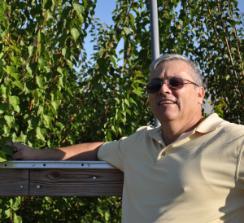By Clint Thompson

The future of Florida peaches rests with its ability to find footing in the northern area of the state. That’s the opinion shared by Jose Chaparro, associate professor in the University of Florida Institute of Food and Agricultural Sciences (UF/IFAS), who equates it to the situation being experienced in Georgia.

“What’s happening is the best places to grow, the adaptation range is slowly migrating north. You’re seeing the same thing in central Georgia. The optimal chilling range for the Fort Valley area is actually going down. We’re going to see this whole trend migrate through north Florida into Georgia,” Chaparro said.
Climate change has impacted the chilling hour requirement that Florida peaches need to produce a crop. As chill hours become less available, it makes it harder for some Florida producers to produce a viable crop every year.
“For the growers, how do you decide what varieties to grow? Those contenders, the Carolina Golds, those varieties that require 1,000 chill hours may no longer be viable varieties in central Georgia. Even in places like Southwest Georgia, 550 (chill hours) in the Bainbridge-Attapulgus area may be too high to produce reliable commercial crops,” Chaparro said. “Are we trying to crack that nut? Yes. We’re trying to develop a system where you could essentially develop genotypes that require no chill; where you defoliate, water and fertilize to force a tree to bloom. But the issue is if you have a fruit on the tree at the end of December, you get a Jan. 15 freeze, you better have freeze protection or you’re not going to have a crop.
“Everything down (in central and south Florida) is warmer. As you increase temperatures, fruit sizes tend to decrease. Realistically, in the Orlando (area), you could be seeing peaches from the first of March to the end of May. But again, the issue comes, as you increase temperatures, you increase problems with smaller fruit size.”










